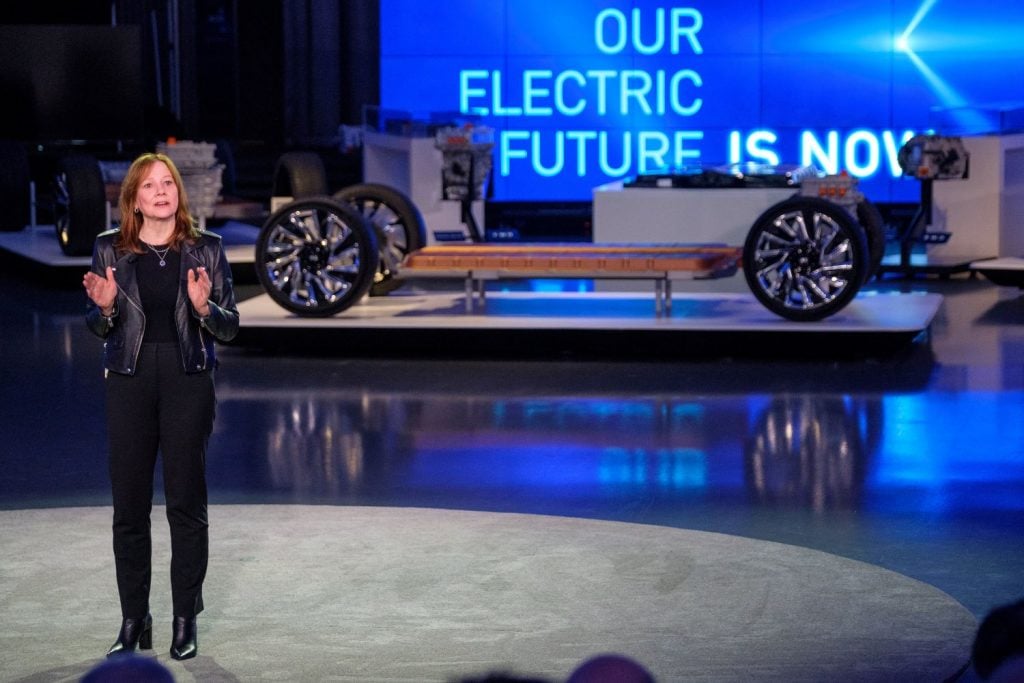GM’s Ultium Battery technology is an energy resource used to power Ultium Drive technology, which are the drive units and motors that comprise the modular propulsion system in GM’s EV strategy.
“Our team accepted the challenge to transform product development at GM and position our company for an all-electric future,” said Mary Barra, GM chairman and CEO. “What we have done is build a multi-brand, multi-segment EV strategy with economies of scale that rival our full-size truck business with much less complexity and even more flexibility.”
Business Benefits
GM’s flexible, modular approach to EV development will drive significant economies of scale and create new revenue opportunities, including
- Reduced Battery Costs: GM’s joint venture with LG Chem will drive battery cell costs below $100/kWh by using a proprietary low cobalt chemistry
- Ongoing technological and manufacturing breakthroughs will drive costs even lower.
- Flexibility: GM’s all-new global platform is flexible enough to build a wide range of trucks, SUVs, crossovers, cars and commercial vehicles with outstanding design, performance, packaging, range and affordability.
- Capital Efficiency: GM can spend less capital to scale its EV business because it is able to leverage existing property, including land, buildings, tools and production equipment such as body shops and paint shops.
- Product Simplification: The vehicle and propulsion systems were designed together to minimize complexity and part counts beyond today’s EVs, which are less complex than conventional vehicles powered by internal combustion engines. For example, GM plans 19 different battery and drive unit configurations initially, compared with 550 internal combustion powertrain combinations available today.
- Customer Acceptance: Third-party forecasters expect U.S. EV volumes to more than double from 2025 to 2030 to about 3 million units on average. GM believes volumes could be materially higher as more EVs are launched in popular segments, charging networks grow and the total cost of ownership to consumers continues to fall.
- New Sources of Revenue: By vertically integrating the manufacture of battery cells, the company can reach beyond its own fleet and license technology to others.
The automaker has stated that its first generation of future EV program will indeed be profitable, and will pave the way for further accretive growth. GM’s technology can be scaled to exceed the projected customer demand of over one million global sales in 2025.

GM revealed an all-new modular architecture and Ultium batteries during a week-long event at the GM Design Dome. Nearly 2,000 employees, investors, dealers, policymakers and media traveled to Warren, Michigan to see the technology firsthand.
Principles
Ultium battery technology works in tandem with Ultium drive technology. As the names imply, the battery stores the energy used by the drive units and motors to propel the vehicle.
Highlights & Capabilities:
- Unique large-format, pouch-style cells can be stacked vertically or horizontally inside the battery pack
- Allows engineers to optimize battery energy storage and layout for every single vehicle application
- Motors designed in-house will support front-wheel drive, rear-wheel drive, all-wheel drive and performance all-wheel drive applications
- Ultium energy options range from 50 to 200 kWh
- GM-estimated range up to 400 miles or more on a full charge
- GM-estimated 0 to 60 mph acceleration as low as 3 seconds
- Ultium-powered EVs are designed for Level 2 and DC fast charging
- Most will have 400-volt battery packs and up to 200 kW fast-charging capability
- Truck platform will have 800-volt battery packs and 350 kW fast-charging capability
How It Works
With a traditional combustion engine, a crankshaft rotates and generates energy, which the transmission then transmits to the wheels via an axle. Comparatively, GM’s Ultium drive technology works very similarly, only the combustion engine is now a battery-powered motor that is housed within the casing – a casing that fittingly resembles the combination of an engine block with a transmission bell housing.
Taking this mechanical metaphor one step further, one could see an Ultium motor as a module-dense transmission with an electrified set of planetary gears that generate force. Alternatively, one could also think of it as an internal engine starter that never stops spinning. This is because Ultium Drive technology combines electric motors and single-speed transmissions to apply power to the front, rear, or all wheels, depending on the vehicle application. Ultium batter technology fits into the mix by creating the energy used to power the Ultium drive unit’s motor(s).
Applications
Ultium battery technology will power every new General Motors electric vehicle, as Ultium is flexible enough to build a wide range of EVs – including cars, trucks, SUVs and even autonomous vehicles. Ultium batteries are at the core of GM’s future EV lineup.
Confirmed applications:
Ultium News
GM’s Ultium Cells Battery Plants Still Not Running At Full Capacity
One facility only operating at 40 percent.
Read More »GM Ultium Cells Ohio Plant Produces 100 Millionth Battery Cell
About two years after production began.
Read More »










